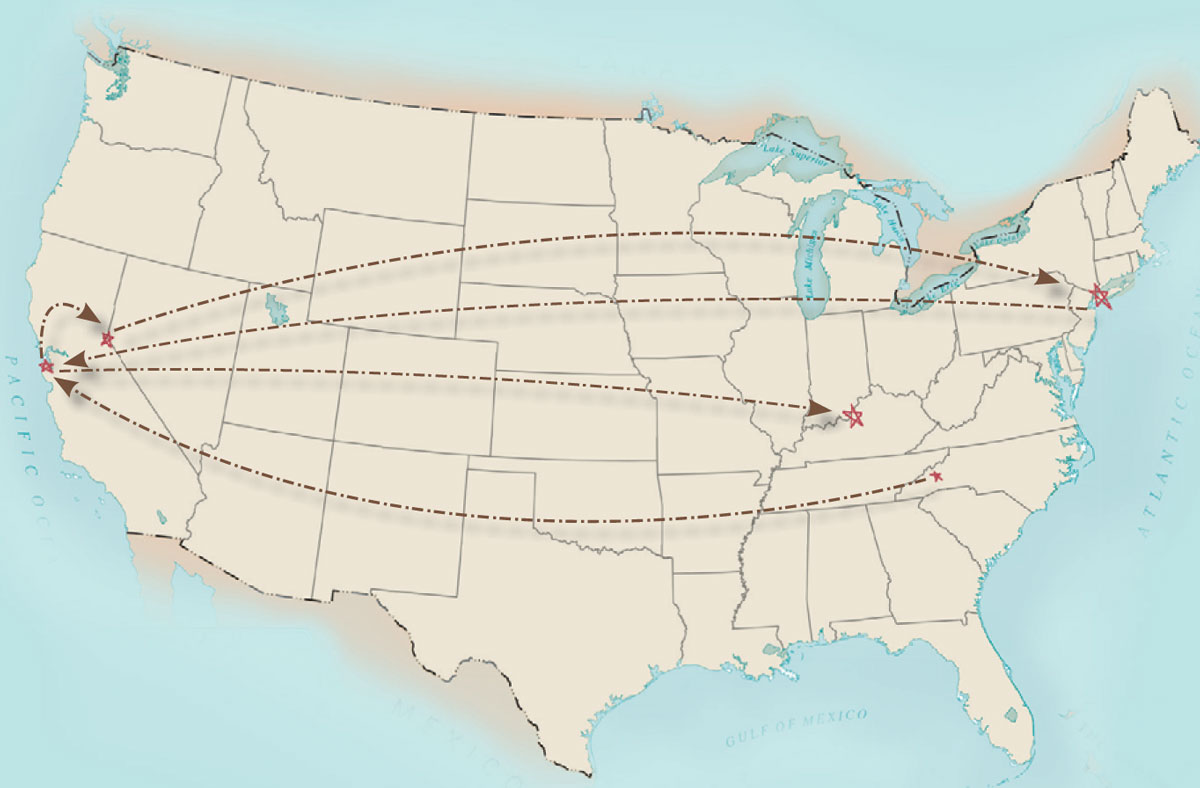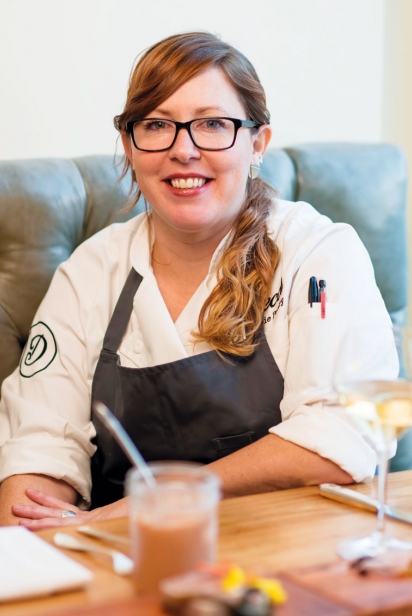Winding Path Led to Decca
Chef Annie Pettry puts lifetime of adventures to work
Raised by “hippies” on 50 acres in Asheville, NC, Decca chef Annie Pettry had what you might call an alternative lifestyle. Five families lived on the land, where, for a time, her family lived in a teepee. “We ate a lot of tofu and tempeh and nutritional yeast,” she recalls. The family grew mushrooms and a garden; there was a trout pond for fishing.
And both parents loved to cook. “Mom was experimental and global,” Annie says, who would make a full Indian dinner with even the chutneys made from scratch. “With my dad it was more like play.” Little wonder that her first work in Asheville was in restaurants.
But when she moved to San Francisco as a young adult it wasn’t to become a chef, it was in search of a certain lifestyle. She was a free spirit, her friends were skateboarders. “I went there to leave my hometown. I wanted to live in a city but also be in nature.” Because restaurants were in her background, she thought a restaurant job would be easy to come by.
It wasn’t. She discovered a professionalism among restaurant workers in San Francisco that she hadn’t experienced at home, and they weren’t desperate for someone who just wanted a job. So she found work for a large company that provided valet parking for venues all over the city, including “half the restaurants in San Francisco,” says Annie.
Parking cars at The Meetinghouse, she was smitten. “I loved it. And I really want a job there,” she says. “It’s the first time I realized a restaurant was a magical place.” After parking cars there several times, she became familiar with the staff, and finally was hired mainly to be the pastry chef ’s assistant. But she also worked the front of the house. “It was the first place I worked where the whole restaurant worked as a team,” she says, “the first place where hospitality was flawless.”
After a three-year pastry stint — during which she helped prepare a dessert of phyllo, chocolate cake and raspberry jam for Julia Child’s 90th birthday party — The Meetinghouse was sold and Annie “took a break,” moving to Lake Tahoe where she “fell in love with snowboarding,” a lifestyle she supported by the work she knew best: bartending, restaurant cooking and waiting tables. In an attempt to “do something with [her] life,” Annie went to massage therapy school.
She hated massage, knew she couldn’t snowboard forever and kept wondering what she should do with her life when it dawned on her that “I love cooking. I’ve always loved cooking,” she said. “I had been look for so long and it was right under my nose.” She took out a loan, moved to New York and attended the French Culinary Institute (now International Culinary Center). While there she worked at Quality Meats, building seafood towers and shucking oysters, then as a line cook for fish, where she learned to “organize [her] thoughts, organize [her] pans” and to hold her spoon like a pencil.
Back in San Francisco with a culinary degree and more than 10 years of experience doing nearly everything one can do in a restaurant, Annie went to work as a sous-chef for Loretta Keller at the Moss Room. Coincidentally, Keller was hired as a consultant by the partners opening Decca in Louisville, who had also worked in San Francisco and with Keller. Keller encouraged Annie to move to Decca, even without knowing the partners, or the town.
“It’s closer to home, you’re ready for your own thing,” Annie recalls Keller telling her. From that moment it was two weeks until she moved to Louisville, where she had six weeks to write the menus, test the dishes, find vendors and suppliers.
And so at Decca after years of working in the front and back of the house at scores of restaurants with a variety of personalities, Annie finds it difficult to describe the type of cooking she does. She looks for pristine ingredients, aims for “stem-to-stock,” and “nose-to-tail,” occasionally adds exotic highlights — ras al hanout on snapper; harissa on grilled octopus.
Finding uses for all parts of an animal challenges her. With pork, “there are so many different cuts,” she says, easily naming pork chop, tenderloin, belly or bacon or pancetta, trotters for soup or gelatin, “really delicious crispy pig ears; tongue tacos are one of my favorites,” she says. Fatback is great for terrines, chicharrones from skin, rilletes and so on.
In fact, says Annie, cooking with the underutilized parts of an animal is often more rewarding than the more popular cuts. At a recent “Lambs and Clams” dinner in Greenville, SC, she could have her pick of lamb — including the tender middle muscle. Instead, she chose the liver and made the dish in the recipe featured below. It’s a riff on a Decca dish, duck liver terrine served with cherry mostarda, grilled focaccia and seasonal pickled vegetables, which is “one of our signatures,” said Annie.
Her chicken liver mousse too, is a delicious dish with a humble start. “I love chicken liver,” she says. “One bite packs a lot of flavor.” If you buy whole chickens, you can freeze the individual livers until you accumulate a pound, or you can substitute a different type of liver, or just buy a whole package of chicken liver. It’s a flexible recipe — you can leave out or change ingredients, keeping the same ratio of liver to yolk to liquid — and it keeps well so it can be made ahead.
Accolades and awards
» Restaurant Hospitality: 15 to Watch in 2015
» FOOD & WINE: People’s Best New Chef nominee (2014)
» StarChefs.com: Rising Star award (2014)
» Rathbun’s Watch List (2014)
» Women Chefs and Restaurateurs: Women Who Inspire nominee (2014)
» Cochon 555: Princess of Pork (2013)
» Eater: Louisville Chef of the Year (2013)






